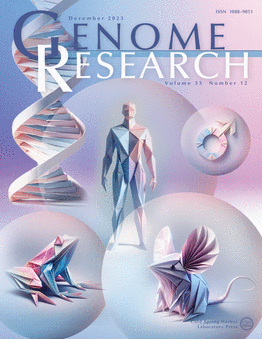出乎意料的低重组率和白蚁基因组热点的存在
IF 6.2
2区 生物学
Q1 BIOCHEMISTRY & MOLECULAR BIOLOGY
引用次数: 0
摘要
减数分裂重组是促进适应和去除有害遗传变异的基本进化过程。社会性膜翅目昆虫在后生动物中表现出最高的重组率,而在非社会性膜翅目昆虫中没有发现高的重组率。目前尚不清楚重组率升高是否是所有群居昆虫的普遍特征。在许多后生动物分类群中,重组主要局限于长度为几千个碱基的热点。然而,人们对昆虫基因组中重组热点的流行程度知之甚少。本文推断了白蚁(Macrotermes bellicosus)和隐白蚁(Cryptotermes secundus)两种昆虫目昆虫基因组的重组率及其精细尺度变异。我们使用基于链接不平衡的方法来推断重组率。我们推测这两个物种的重组率接近1 cM/Mb,与后生动物的平均重组率相似。我们还观察到重组在两种白蚁基因组中的高度点状分布,表明重组热点的存在。我们推断这两个物种的基因组中都存在全长PRDM9基因,这表明白蚁的重组热点可能是由PRDM9决定的,就像它们在哺乳动物中一样。我们还发现基因重组率与推断的种系DNA甲基化水平相关。白蚁的低重组率的发现表明,群居性并不普遍与重组率的升高有关。我们推测,社会膜翅目昆虫中较高的重组率是由单倍体雄性之间的强烈选择所促进的。本文章由计算机程序翻译,如有差异,请以英文原文为准。
Unexpectedly low recombination rates and presence of hotspots in termite genomes
Meiotic recombination is a fundamental evolutionary process that facilitates adaptation and the removal of deleterious genetic variation. Social Hymenoptera exhibit some of the highest recombination rates among metazoans, whereas high recombination rates have not been found among nonsocial species from this insect order. It is unknown whether elevated recombination rates are a ubiquitous feature of all social insects. In many metazoan taxa, recombination is mainly restricted to hotspots a few kilobases in length. However, little is known about the prevalence of recombination hotspots in insect genomes. Here we infer recombination rate and its fine-scale variation across the genomes of two social species from the insect order Blattodea: the termites Macrotermes bellicosus and Cryptotermes secundus. We used linkage-disequilibrium-based methods to infer recombination rate. We infer that recombination rates are close to 1 cM/Mb in both species, similar to the average metazoan rate. We also observed a highly punctate distribution of recombination in both termite genomes, indicative of the presence of recombination hotspots. We infer the presence of full-length PRDM9 genes in the genomes of both species, which suggests recombination hotspots in termites might be determined by PRDM9, as they are in mammals. We also find that recombination rates in genes are correlated with inferred levels of germline DNA methylation. The finding of low recombination rates in termites indicates that eusociality is not universally connected to elevated recombination rate. We speculate that the elevated recombination rates in social Hymenoptera are instead promoted by intense selection among haploid males.
求助全文
通过发布文献求助,成功后即可免费获取论文全文。
去求助
来源期刊

Genome research
生物-生化与分子生物学
CiteScore
12.40
自引率
1.40%
发文量
140
审稿时长
6 months
期刊介绍:
Launched in 1995, Genome Research is an international, continuously published, peer-reviewed journal that focuses on research that provides novel insights into the genome biology of all organisms, including advances in genomic medicine.
Among the topics considered by the journal are genome structure and function, comparative genomics, molecular evolution, genome-scale quantitative and population genetics, proteomics, epigenomics, and systems biology. The journal also features exciting gene discoveries and reports of cutting-edge computational biology and high-throughput methodologies.
New data in these areas are published as research papers, or methods and resource reports that provide novel information on technologies or tools that will be of interest to a broad readership. Complete data sets are presented electronically on the journal''s web site where appropriate. The journal also provides Reviews, Perspectives, and Insight/Outlook articles, which present commentary on the latest advances published both here and elsewhere, placing such progress in its broader biological context.
 求助内容:
求助内容: 应助结果提醒方式:
应助结果提醒方式:


